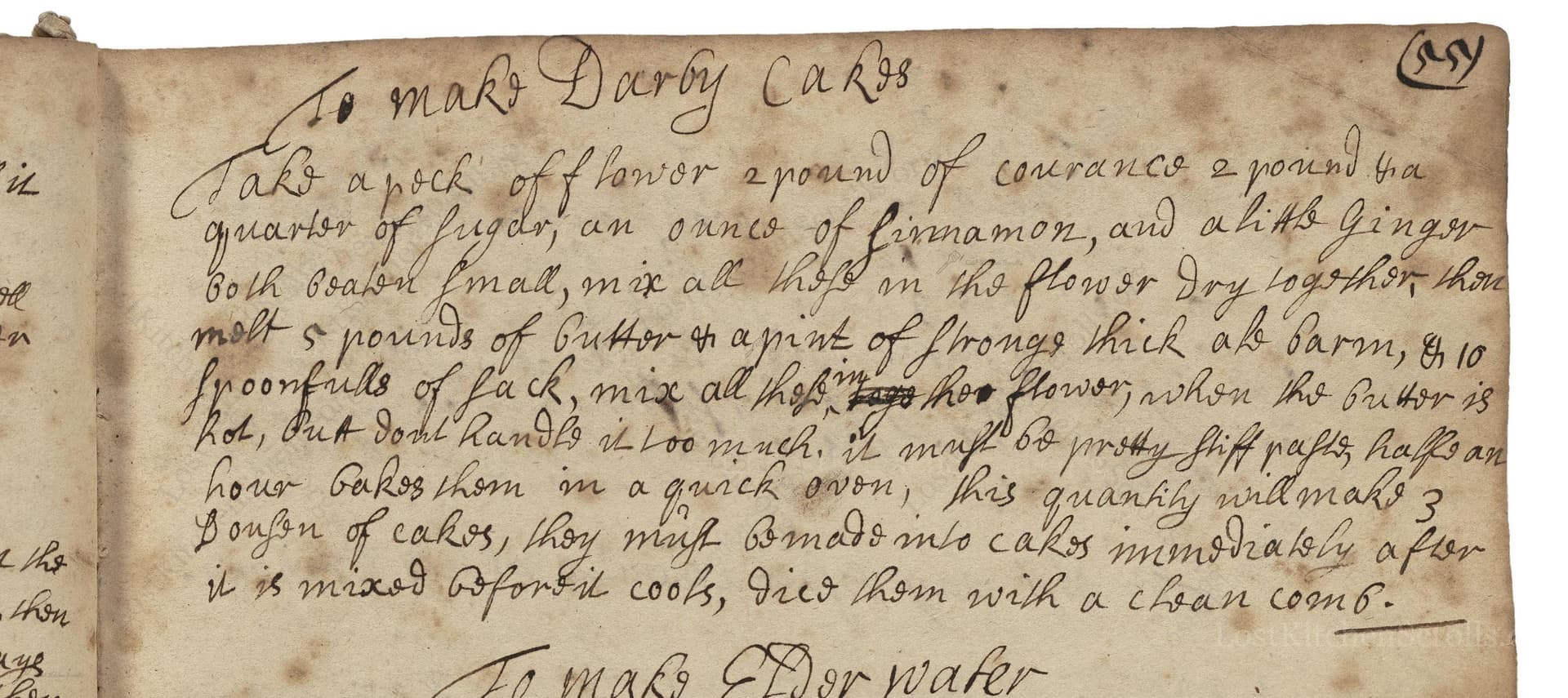To Make Darby Cakes
From the treasured pages of Receipt book of Jane Staveley
Written by Jane Staveley

To Make Darby Cakes
"Take a peck of flower a pound of courance a pound & a quarter of suger, an ounce of cinnamon, and a little ginger both beaten small, mix all these in the flower dry together, then melt 5 pounds of Butter & a pint of stronge thick ale barm, & 10 spoonfulls of sack, mix all these hot, but dont handle it too much, it must be pretty stiff paste, half an hour bakes them in a quick oven, this quantity will make 3 dozen of cakes, they must be made into cakes imediatly after it is mixed befor it cools, dice them with a clean comb."
Note on the Original Text
This recipe reflects typical 17th-century English kitchen practice: quantities are immense, assuming the needs of a large household or to allow for preservation. Instructions are brief, with little explanation, as culinary knowledge was assumed. Spelling and ingredient names are archaic—'flower' for flour, 'courance' for currants, 'suger' for sugar—and the term 'barm' refers to ale yeast instead of the cultured yeast we use now. The use of a 'quick oven' means a hot oven, and 'dice them with a clean comb' is a playful way to score the surface, familiar to cooks of the period.

Title
Receipt book of Jane Staveley (1693)
You can also click the book image above to peruse the original tome
Writer
Jane Staveley
Era
1693
Publisher
Unknown
Background
Step into the flavorful annals of the 17th century with Jane Staveley’s delightful culinary collection. Brimming with time-honored recipes and refined instructions, this book offers a sumptuous glimpse into the kitchens of yesteryear—where classic techniques met noble tastes and every dish was a celebration of ingenuity.
Kindly made available by
Folger Shakespeare Library
This recipe for Darby Cakes was transcribed by Jane Staveley in England between 1693 and 1694, at a time when home baking was an essential domestic art rather than a hobby. Cakes in this era fell somewhere between sweetened breads and modern cakes, and often relied on ale barm—yeasty residue from brewing—for leavening, before baking powder or commercial yeast took over the scene. 'Sack' refers to a fortified white wine, similar to today's sherry, popular in 17th-century England. Such cakes would have been made in large quantities for celebrations or as a staple treat in a prosperous household.

Preparation would have involved a large wooden mixing tray for the stiff dough, a heavy saucepan (likely copper or iron) for melting quantities of butter, and a stone or earthenware baking surface set inside a brick or wood-fired oven. The marking of the cakes with a comb reflects the absence of patterned cutters or specialized tools; a simple, everyday clean comb or a fork sufficed for decorative scoring. Barm would be skimmed from ale barrels, and heavy wooden spoons or hands would mix the dough. Cakes were shaped and moved by hand, leveraging the warmth from the freshly melted butter.
Prep Time
30 mins
Cook Time
30 mins
Servings
36
We've done our best to adapt this historical recipe for modern kitchens, but some details may still need refinement. We warmly welcome feedback from fellow cooks and culinary historians — your insights support the entire community!
Ingredients
- 9 lb plain wheat flour
- 1 lb currants
- 1 lb 4 oz caster sugar
- 1 oz ground cinnamon
- 0.2 oz (about 1 tsp) ground ginger
- 5 lb unsalted butter
- 1 pint strong beer barm (or 1.5 oz fresh baker's yeast mixed with 1 pint warm ale as a substitute)
- 5 fl oz dry sherry (as a modern substitute for 'sack')
Instructions
- To make Darby Cakes in a modern kitchen, begin by thoroughly blending 9 lb plain wheat flour with 1 lb currants, 1 lb 4 oz caster sugar, 1 oz ground cinnamon, and 0.2 oz (about 1 tsp) ground ginger.
- In a saucepan, gently melt 5 lb unsalted butter.
- While the butter is still hot, stir in 1 pint active, unpasteurized beer barm (or 1.5 oz fresh baker’s yeast with a tablespoon of ale as a substitute) and 10 tablespoons (about 5 fl oz) of dry sherry or white wine (as a modern 'sack').
- Combine the dry and wet mixtures swiftly, being careful not to overwork the dough—aim for a stiff paste.
- Quickly shape into flat rounds (approximately the size of your palm), and, while still warm, mark the tops with the tines of a clean comb or fork.
- Bake immediately in a preheated, hot oven at 425°F for about 30 minutes or until rich golden.
- This recipe will yield about 36 cakes.
Estimated Calories
375 per serving
Cooking Estimates
You will spend about 30 minutes mixing and shaping the dough, then bake the cakes in the oven for another 30 minutes. Each cake has about 375 calories, and you get 36 cakes in total.
As noted above, we have made our best effort to translate and adapt this historical recipe for modern kitchens, taking into account ingredients nowadays, cooking techniques, measurements, and so on. However, historical recipes often contain assumptions that require interpretation.
We'd love for anyone to help improve these adaptations. Community contributions are highly welcome. If you have suggestions, corrections, or cooking tips based on your experience with this recipe, please share them below.
Join the Discussion
Rate This Recipe

Den Bockfisch In Einer Fleisch Suppen Zu Kochen
This recipe hails from a German manuscript cookbook compiled in 1696, a time whe...

Die Grieß Nudlen Zumachen
This recipe comes from a rather mysterious manuscript cookbook, penned anonymous...

Ein Boudain
This recipe comes from an anonymous German-language manuscript cookbook from 169...

Ein Gesaltzen Citroni
This recipe, dating from 1696, comes from an extensive anonymous German cookbook...
Browse our complete collection of time-honored recipes



